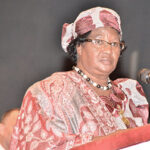Global Education is in crisis. Today, nearly 300 million children don’t go to school, and 800 million young people will leave school without any qualifications. Recent data show that global learning poverty in low- and middle-income countries is estimated to have risen to 70%, with more than half of the world’s children unable to read or write a simple text at the age of ten and no accredited skills for the workplace when they leave school. Coupled with the “violation” of children’s right to education, evidenced by these high levels of learning poverty, this is bound to have a devastating impact on future productivity, earnings, and well-being for this generation of children and youth, their families, and the world’s economy.
Education budgets in low- and lower-middle-income countries will have to more than double, to $3 trillion, by 2030 if we are to achieve SDG4. Unless we address the shortcomings in education investment, the loss in lifetime earnings of the current generation of school-age children and youth is estimated to reach more than 15% of today’s global GDP ($21 trillion). This economic cost will be disproportionately borne by low- and middle-income countries and their students, further aggravating already serious intergenerational inequalities and divides, as well as gaps and divides among and within countries.
Despite this recognized demand for investment, countries across the globe have had to cope with the financial pressures of the COVID-19 pandemic, now compounded by the food, energy, debt, and currency crises triggered and exacerbated by the war in Ukraine. But the reduction in education spending is particularly damaging, because an educated and skilled workforce is central to achieving economic recovery and growth, escaping poverty, and eliminating the gender and wealth disparities that continue to plague our societies. While the internationally recommended level of spending on education is at least 4% of GDP, the majority of the world’s 82 low- and lower-middle-income countries continue to underspend – in some cases, less than 2% of GDP.
And, sadly, despite their promises, the official development assistance that rich countries channel to education has been falling, too – from 8.4% of ODA in 2010 to just 6.5% in 2020. Today, even when the world’s education aid is combined, including from bilateral and multilateral sources, it amounts to just $18 per African child, hardly enough to pay for a textbook, much less a teacher or a classroom.
This month, UN Secretary-General António Guterres will convene the Transforming Education Summit in New York City. With COVID-19 waning, and in light of the complexity of converging crises, we must shift resolutely into build-back-better mode and address the enormous challenge of access to education for all, on which much of our future will depend. Without addressing the persistent exclusion of minorities, migrants, refugees, and other marginalized groups in our education systems, the entrenchment of existing inequalities within societies will only deepen, and we will fail to achieve inclusive, peaceful, and sustained development.
Modernization of education systems through better training and rewards for teachers, the application of new technologies and digital learning, and new pathways for skills training will have significant impact on the outcomes we are able to achieve – but so will money. One proposal now being considered is for a global education coalition between developing countries and the developed economies that provide donor aid.
Through such a compact, countries would agree to raise education spending in stages to at least 4-6% of their national income over a period of five years, and invest at least 15-20% of all of their public spending in education.
Sustainable funding for education can be increased through domestic action to reform national tax systems, coupled with international action to close tax loopholes and choke off illicit financial flows. Implementing taxation reforms that support equity and redistribution can address critical poverty and inequality challenges in many low- and middle-income countries. In parallel, multilateral institutions can offer enhanced support to encourage the fast-tracking of educational opportunities.
The World Bank’s financing facility for low-income countries – the International Development Association (IDA) – could increase the share of its spending on education from 10% to 15% by leveraging new resources from donors and enhanced use of its reflows – the capital returned from past loans. Larger support for schools and teachers in the developing world alone would unlock education opportunities for more than 20 million children every year in the poorest countries.
Most out-of-school children are located in lower-middle-income countries, which host a large share of the world’s refugees and displaced young people. But the International Bank for Reconstruction and Development (IBRD), the World Bank’s financing facility for middle-income countries, currently allocates just 4% of its loans to education in lower-middle-income countries (home to 700 million children), down from an already low 8% in 2010.
IDA and IBRD funding could be complemented by the International Finance Facility for Education proposed several years ago by the Education Commission in the Learning Generation report. This facility would fund education programs in low- and lower-middle-income countries at low interest rates, akin to that of IDA’s credits, using guarantees backed by grants from donor countries through the various multilateral development banks.
Such funding would be additional to bilateral aid from Development Assistance Committee donors who would commit to higher ODA levels. A greater amount of the ODA would be channeled through international and multilateral institutions, including UNESCO, UNICEF, and other UN agencies, and through educational initiatives such as the Global Partnership for Education and Education Cannot Wait. Funding could be further enhanced by a call for greater and more innovative social-impact investments in the education sector through cross-border individual funding and corporate philanthropy.
Over the next five years, this plan could produce an extra $10 billion of new educational funds for low-income countries, together with $10 billion in additional resources for middle-income countries.
In the 2021 Our Common Agenda report, Guterres identifies the need for a second World Social Summit in 2025. This event could serve as a critical platform to support better coordination and more innovative responses to catalyze the type of initiatives needed to transform the education sector globally.
We are so far from achieving our goal of universal education by 2030 that, unless we act quickly and generously, we will fall further behind on our SDG4 commitment to “ensure inclusive and equitable quality education and promote lifelong learning opportunities for all.” We therefore call on countries to support these bold measures.
We can be the first generation in history in which every child goes to school. Instead of developing some of the potential for some children in some countries, we can develop all of the potential for all children in all countries. But we have to act. To achieve this, we urge all countries in the UN family to support this initiative at the summit this month.



